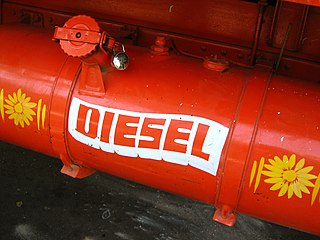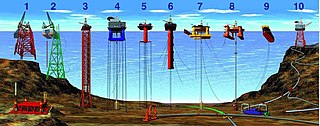The Oil Industry Safety Directorate (OISD) is a technical advisory body in India. It was established in 1986 by Ministry of Petroleum and Natural Gas. [1] [2] [3] The OISD formulates and implements safety standards for the oil industry.
The main responsibilities OISD are:
OISD has framed rules and guidelines for safe distances to be observed for various facilities in an oil installation. All the new liquefied petroleum gas (LPG) bottling plants in India are designed based on the guidelines of OISD. OISD has also issued guidelines for the safe operations of petrol stations and standards related to petroleum installations. [2]

A filling station is a facility that sells fuel and engine lubricants for motor vehicles. The most common fuels sold in the 2010s were gasoline and diesel fuel.

Diesel fuel, also called diesel oil or historically heavy oil, is any liquid fuel specifically designed for use in a diesel engine, a type of internal combustion engine in which fuel ignition takes place without a spark as a result of compression of the inlet air and then injection of fuel. Therefore, diesel fuel needs good compression ignition characteristics.

An oil refinery or petroleum refinery is an industrial process plant where petroleum is transformed and refined into useful products such as gasoline (petrol), diesel fuel, asphalt base, fuel oils, heating oil, kerosene, liquefied petroleum gas and petroleum naphtha. Petrochemicals feedstock like ethylene and propylene can also be produced directly by cracking crude oil without the need of using refined products of crude oil such as naphtha. The crude oil feedstock has typically been processed by an oil production plant. There is usually an oil depot at or near an oil refinery for the storage of incoming crude oil feedstock as well as bulk liquid products. In 2020, the total capacity of global refineries for crude oil was about 101.2 million barrels per day.

Liquefied petroleum gas is a fuel gas which contains a flammable mixture of hydrocarbon gases, specifically propane, propylene, butylene, isobutane, and n-butane.

Lock out, tag out (LOTO) is a safety procedure used to ensure that dangerous equipment is properly shut off and not able to be started up again prior to the completion of maintenance or repair work. It requires that hazardous energy sources be "isolated and rendered inoperative" before work is started on the equipment in question. The isolated power sources are then locked and a tag is placed on the lock identifying the worker and reason the LOTO is placed on it. The worker then holds the key for the lock, ensuring that only they can remove the lock and start the equipment. This prevents accidental startup of equipment while it is in a hazardous state or while a worker is in direct contact with it.

An oil terminal is an industrial facility for the storage of oil, petroleum and petrochemical products, and from which these products are transported to end users or other storage facilities. An oil terminal typically has a variety of above or below ground tankage; facilities for inter-tank transfer; pumping facilities; loading gantries for filling road tankers or barges; ship loading/unloading equipment at marine terminals; and pipeline connections.

NNPC Limited is a for profit oil company in Nigeria. Formerly a government-owned corporation, it was transformed from a corporation to a limited liability company in July 2022. NNPC Limited is the only entity licensed to operate in the country's petroleum industry. It partners with foreign oil companies to exploit Nigeria's fossil fuel resources.
The Institute of Petroleum (IP) was a UK-based professional organisation founded in 1913 as the Institute of Petroleum Technologists. It changed its name to the Institute of Petroleum in 1938. The institute became defunct when it merged with the Institute of Energy in 2003 to form the Energy Institute.

Naftna Industrija Srbije is a Serbian multinational oil and gas company with headquarters in NIS building, Novi Sad, Serbia. NIS is one of the most profitable companies in Serbia and one of the largest domestic exporters. It employs around 11,000 people in Serbia and the region. As of May 2022, Gazprom Neft is the largest shareholder with 50% of NIS shares, followed by 29.87% owned by the Government of Serbia, 5% owned by Gazprom and rest by minority shareholders.

The Oil and Natural Gas Corporation Limited (ONGC) is an Indian central public sector undertaking under the ownership of Ministry of Petroleum and Natural Gas, Government of India. It is headquartered in New Delhi. ONGC was founded on 14 August 1956 by the Government of India. It is the largest government-owned-oil and gas explorer and producer in the country and produces around 70 percent of India's domestic production of crude oil and around 84 percent of natural gas. In November 2010, the Government of India conferred the Maharatna status to ONGC.

Hindustan Petroleum Corporation Limited (HPCL), commonly referred to as HP, is a subsidiary of Oil and Natural Gas Corporation which is in turn under the ownership of the Ministry of Petroleum and Natural Gas, Government of India. It is headquartered in Mumbai. Since 2018, Oil and Natural Gas Corporation has owned majority of its stake. It is ranked 367th on the Fortune Global 500 list of the world's biggest corporations as of 2016. On 24 October 2019, it became a Maharatna PSU.
Standardization in oil industry seeks to promote a better standardization within the oil and energy industry. It promotes this objective by highlighting areas where standardization has worked well, where it has not, and why. This provokes discussions for better standardization. The overall purpose of the document is to issue a guideline on the application of IEC 61508 and IEC 61511 in the Norwegian Petroleum Industry, and thereby simplify the use of the standards.

The Ministry of Petroleum and Natural Gas (MOP&NG) is a ministry of the government of India responsible for the exploration, production, refining, distribution, marketing, import, export, and conservation of petroleum, natural gas, petroleum products, and liquefied natural gas in the country. The ministry is headed by the Cabinet Minister Hardeep Singh Puri. M. M. Kutty is the Secretary of the Ministry.

The oil and gas industry plays a central role in the economy of the United Kingdom. Oil and gas account for more than three-quarters of the UK's total primary energy needs. Oil provides 97 per cent of the fuel for transport, and gas is a key fuel for heating and electricity generation. Transport, heating and electricity each account for about one-third of the UK's primary energy needs. Oil and gas are also major feedstocks for the petrochemicals industries producing pharmaceuticals, plastics, cosmetics and domestic appliances.
Permit-to-work (PTW) refers to management systems used to ensure that work is done safely and efficiently. These are used in hazardous industries and involve procedures to request, review, authorise, document and most importantly, de-conflict tasks to be carried out by front line workers. Permit to work is an essential part of control of work (COW), the integrated management of business critical maintenance processes. Control of work is made up of permit to work, hazard identification and risk assessment (RA), and isolation management (IM).
The Directorate General of Hydrocarbon (DGH) is the Indian governmental regulatory body under the Ministry of Petroleum and Natural Gas.
The petroleum industry in India dates back to 1889 when the first oil deposits in the country were discovered near the town of Digboi in the state of Assam. The natural gas industry in India began in the 1960s with the discovery of gas fields in Assam and Maharashtra. As on 31 March 2018, India had estimated crude oil reserves of 594.49 million metric tonnes (Mt) and natural gas reserves of 1339.57 billion cubic metres of natural gas (BCM).

Offshore installation security is the protection of maritime installations from intentional harm. As part of general maritime security, offshore installation security is defined as the installation's ability to combat unauthorized acts designed to cause intentional harm to the installation. The security of offshore installations is vital as not only may a threat result in personal, economic, and financial losses, but it also concerns the strategic aspects of the petroleum market and geopolitics.
ISO Technical Committee 67 – Oil and gas industries including lower carbon energy is a technical committee within the International Organization for Standardization (ISO). ISO/TC 67 is responsible for developing and maintaining international standards in the worldwide upstream, midstream and downstream oil and gas industry and related lower carbon energy activities. Its role encompasses the harmonisation of standards for facilities, equipment and operations used for drilling, production, pipeline transport and processing of liquids and gaseous hydrocarbons on, and between, offshore oil and gas installations and onshore terminals and oil refineries.